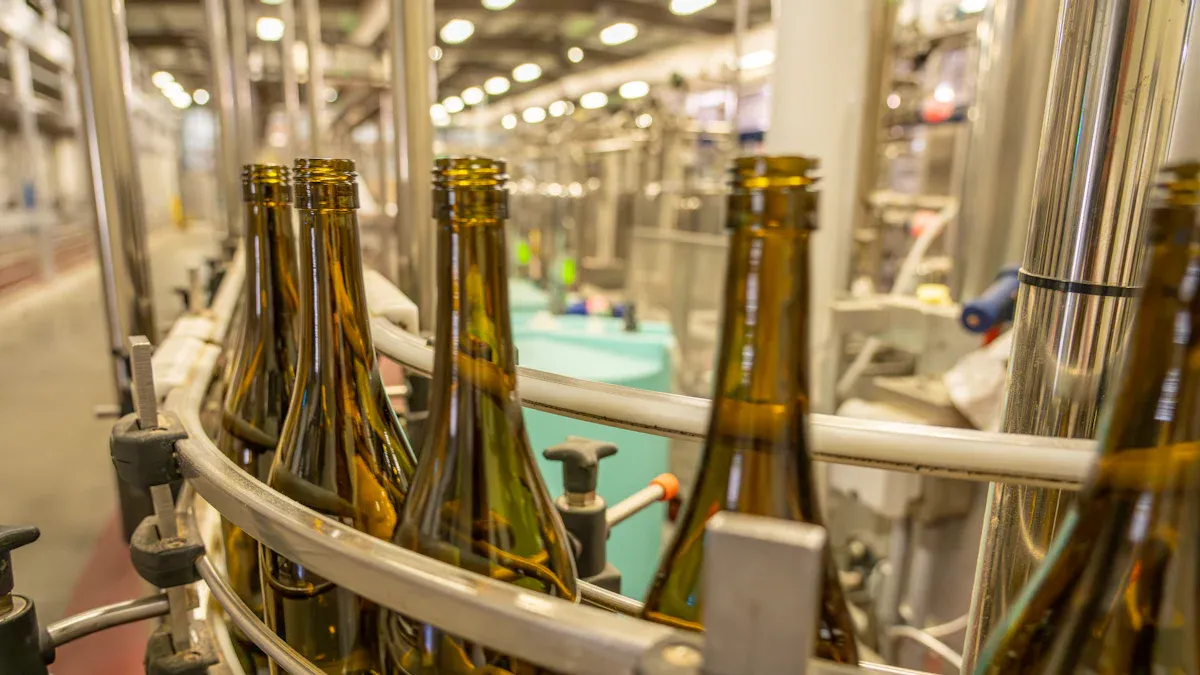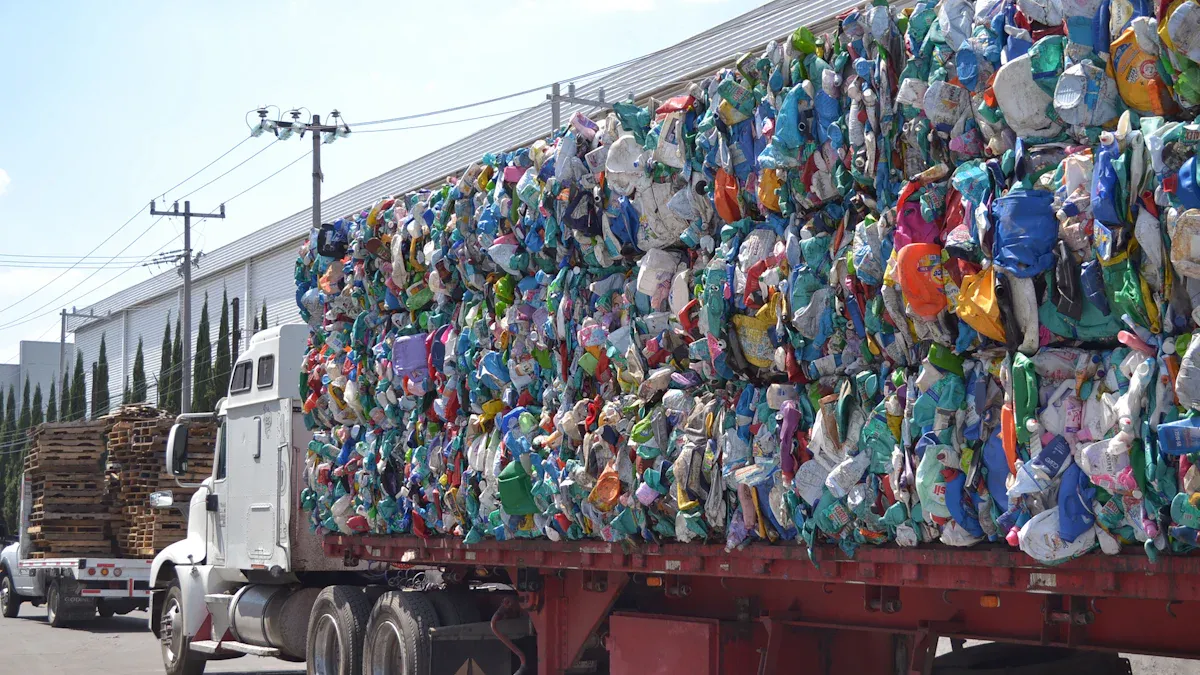Which Has a Lower Carbon Footprint Glass or Plastic
Table of Contents

The glass vs plastic debate has a surprising answer for its environmental footprint.
Many people believe glass is the greener choice. However, plastic containers often have a lower carbon footprint than glass containers.
This difference comes from two key areas. Manufacturing uses less energy, and the lighter weight of plastic makes it easier to transport than heavy glass. A true comparison of glass requires looking at its entire life, from creation to disposal, to understand its full footprint.
THE CARBON FOOTPRINT OF GLASS VS PLASTIC
A product’s total environmental footprint comes from its entire lifecycle. Looking at glass and plastic from start to finish reveals a surprising leader in the carbon footprint race. The data shows a significant difference in the impact of each material across three key stages: manufacturing, sourcing, and transportation.
Manufacturing Energy and Emissions
The production process is a major source of emissions for both materials. Glass manufacturing requires enormous amounts of energy. Furnaces must reach extreme temperatures between 1400°C and 1600°C to melt raw materials into glass. Plastic, in contrast, melts at a much lower temperature of around 170°C. This vast difference means making plastic bottles uses significantly less energy than making glass bottles.
The emissions from making glass come from two main sources:
- Energy use to heat the furnaces to high temperatures.
- Chemical reactions from melting raw materials like limestone and soda ash.
Plastic production also creates emissions, with about 90% happening during the manufacturing stage. The process of turning fossil fuels into plastic packaging generates the most greenhouse gases.
| Stage of Plastic Production | Percentage of GHG Emissions |
|---|---|
| Creating monomers | 26% |
| Refining and producing other ingredients | 29% |
| Pulling feedstock oil and gas from the ground | 20% |
This difference in production energy creates a large gap in the carbon impact of the final products. A study comparing similar containers found that a single glass jar has a much larger footprint.
It can take five plastic jars to equal the carbon impact of just one glass jar.
Raw Material Sourcing
The journey for both materials begins long before the factory. Sourcing raw materials has its own environmental costs. Glass comes from silica sand. Mining this sand can lead to several problems:
- Deforestation and habitat destruction
- Soil erosion
- Depletion of natural resources like water
- Airborne silica dust, which is a health hazard
Transportation and Weight
Weight plays a critical role in the carbon footprint of packaging. Heavier items require more fuel to transport, which creates more emissions. Glass is significantly heavier than plastic. A 500ml glass bottle, for example, can weigh around 400 grams. A plastic bottle of the same size weighs only about 12 grams. This means you can ship many more plastic bottles for the same amount of fuel as a smaller number of glass bottles.
The weight of packaging directly affects distribution emissions.
- Lighter packaging reduces the total weight of a shipment.
- Less weight means trucks, ships, and planes burn less fuel.
- Lower fuel consumption leads to fewer greenhouse gas emissions.
Choosing lightweight materials for bottles and other packaging is a key strategy for companies looking to reduce their environmental footprint. The lighter weight of plastic gives it a clear advantage over heavy glass during shipping and distribution.
A CLOSER LOOK AT PRODUCTION

The manufacturing stage reveals the biggest difference in the carbon footprints of glass and plastic. The energy needed to create each material is vastly different. This step alone accounts for a huge portion of each product’s total environmental impact.
The High Energy Cost of Glass
Glass production needs a lot of energy. The process starts by melting raw materials like sand in massive furnaces. These furnaces must reach extremely high temperatures, often between 1550–1600ºC (2822–2912ºF), to turn the solid batch into molten glass. Keeping these furnaces hot around the clock consumes an enormous amount of fuel.
This intense energy use leads to significant carbon emissions. The global glass manufacturing industry is a major contributor to greenhouse gases.
As of 2022, worldwide glass production was responsible for 95 million metric tons of carbon dioxide emissions. For every ton of glass packaging made, the process releases a substantial amount of CO2.
The high heat required for glass production is the main reason for its large carbon footprint. Even with modern efficiencies, creating a single ton of new glass still demands a significant amount of power. The entire glass production process is built around maintaining these extreme temperatures.
The Lower-Energy Process for Plastic
The production process for plastic requires much less energy than it does for glass. Creating plastic containers, such as those from PET plastic, happens at far lower temperatures. The melting temperature for PET plastic is only around 260°C (500°F). This is a fraction of the heat needed for glass production.
The temperatures for molding plastic are also relatively low, as shown in the chart below.

This chart shows that the highest temperatures for making plastic parts are still hundreds of degrees cooler than the temperatures needed for glass. Because less heat is required, the manufacturing process for plastic burns less fuel and releases fewer greenhouse gases. This lower energy demand is a key reason why plastic often has a smaller carbon footprint.
RECYCLING REALITIES

Many people champion glass because it is “100% recyclable.” While this is true, the full story of recycling reveals a more complex picture. The process of recycling both glass and plastic has unique challenges that affect their overall carbon footprints. A closer look at the realities of recycling is essential.
The Reality of Recycling Glass
Glass holds a key advantage in recycling. It can be melted down and remade into new containers endlessly without losing quality. Using recycled glass also saves energy compared to making new glass from raw materials. However, the glass recycling process is still very energy-intensive. Furnaces must reach high temperatures to melt the recycled glass cullet.
The process of recycling glass still requires a significant amount of energy. Transporting heavy glass to recycling centers also adds to its carbon footprint, as more fuel is needed for collection and shipping.
Even with these energy needs, using recycled glass is better than using virgin materials. The glass recycling process for every ton of recycled glass saves a substantial amount of CO2. Effective glass recycling depends heavily on efficient collection systems.
The Limits of Recycling Plastic
Plastic recycling faces a major challenge called “downcycling.” Unlike glass, plastic often loses quality each time it is processed. A recycled plastic bottle might become a lower-grade product like carpeting or a park bench, which often cannot be recycled again. This process shortens the material’s life cycle.
This limitation is a key reason why global plastic recycling rates are so low.
- Globally, less than 10% of all plastic waste is actually recycled.
- Different types of plastic cannot be mixed, making sorting difficult.
- Contaminants can easily ruin a batch of recycled material.
The recycling process for plastic uses less energy than for glass, but its limitations mean it is not a perfect circular solution.
Comparing National Recycling Rates
The success of recycling programs varies greatly around the world. This difference is very clear when comparing glass recycling rates.
Many European countries have highly effective systems that result in high recycling rates. For example, countries like Germany and Denmark use container deposit return schemes. These programs give people a small refund for returning empty packaging, leading to return rates above 90%. These systems show that strong infrastructure is key to successful recycling for both recycled glass and other materials. The high recovery of recycled glass in these regions makes the material a more sustainable option there.
A full carbon footprint analysis shows plastic often has a lower environmental footprint than glass. This is due to lower energy needs in production and lighter weight for transport. However, the total environmental impact is complex, and neither material is a perfect sustainable alternative. The most sustainable action for the environment is not choosing one over the other.
The best path to sustainability is to reduce and reuse. Reusing containers creates the most sustainable impact for long-term sustainability. This simple choice promotes true sustainability and has a greater positive impact than recycling alone.
FAQ
Which container is better if I plan to reuse it?
Reusing any container lowers its environmental impact. Glass is very durable. It can be washed and refilled many times without losing quality, making it an excellent choice for long-term reuse at home.
Why is glass so much heavier than plastic?
Glass has a higher density than plastic. Its molecules are packed more tightly together. This molecular structure gives glass more mass in the same amount of space, making it much heavier.
Does recycling glass actually save energy?
Yes, recycling glass saves a significant amount of energy. Recycled glass melts at a lower temperature than the raw materials used to make new glass. This process reduces fuel consumption in furnaces.
What creates the biggest part of plastic’s carbon footprint?
The manufacturing stage creates the largest part of plastic’s carbon footprint. The process of converting fossil fuels into plastic resins is energy-intensive. It releases the most greenhouse gases in plastic’s lifecycle.

Poseidon
Master of Nutritional Epidemiology, University of Copenhagen, Herbal Functional Nutrition Researcher
Focus: The scientific application of natural active ingredients such as Tongo Ali, Horny Goat Weed, and Maca to sexual health and metabolic regulation.
Core Focus:
Men: Use a combination of Tongo Ali (an energizing factor) + Maca (an energy reserve) to improve low energy and fluctuating libido.
Women: Use a combination of Horny Goat Weed (a gentle regulator) + Maca (a nutritional synergist) to alleviate low libido and hormonal imbalances.
Stressed/Middle-Aged Adults: This triple-ingredient synergy supports metabolism, physical strength, and intimacy.
Product Concept:
Based on traditional applications and modern research (e.g., Tongo Ali promotes testosterone-enhancing enzyme activity, and icariin provides gentle regulation), we preserve core active ingredients and eschew conceptual packaging—using natural ingredients to address specific needs.
Simply put: I'm a nutritionist who understands "herbal actives." I use scientifically proven ingredients like Tongo Ali, Epimedium, and Maca to help you make "sexual health" and "nutritional support" a daily routine.
